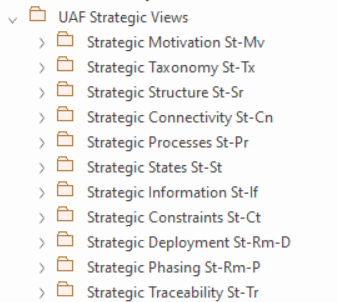| Prev | Next |
UAF Strategic Views
The UAF 1.2 Strategic Viewpoints offer a structured way to capture and analyze the high-level context that shapes enterprise architecture decisions and capability planning. Their purpose is to highlight the key drivers, challenges, and opportunities that influence an organization’s strategic direction, creating the baseline from which capabilities are defined and validated. Through these viewpoints, architects and planners can represent the relationships between external forces, internal constraints, competitive advantages, and the capabilities required to meet strategic aims. This structured representation ensures that business goals are directly connected to architectural choices, providing a clear rationale for technical and operational decisions while maintaining alignment with the organization’s overarching mission and long-term objectives.

UAF Strategic Views
|
Strategic Motivation St-Mv |
Stakeholders: Enterprise Architects, Portfolio Managers, Enterprise Systems Engineers, Program Managers. Concerns: Architecture drivers, challenges, opportunities, capabilities that address opportunities, phases and architectures that address challenges. Definition: Identifies and defines the drivers, challenges, and opportunities that are applicable to the architecture; defines the desired outcomes, goals, and objectives that are motivated by the drivers; and the opportunities that enable the goals and objectives. |
|
Strategic Taxonomy St-Tx |
Stakeholders: Project Managers, Enterprise Architects, Executives. Concerns: Capability needs. Definition: Shows the taxonomy of capabilities. |
|
Strategic Structure St-Sr |
Stakeholders: Program/Project Managers, Portfolio Managers, Enterprise Architects, Executives. Concerns: Capability composition. Definition: Shows the composition of capabilities. |
|
Strategic Connectivity St-Cn |
Stakeholders: PMs, Executives, Enterprise Architects. Concerns: Capability dependencies. Definition: Describes the dependencies between planned capabilities. |
|
Strategic Processes St-Pr |
Stakeholders: Program and Project Managers, Portfolio Managers, Enterprise Architects, Executives. Concerns: Capability phasing. Definition: Shows the relationship between strategic phases and the Capabilities that are intended to be developed during the strategic phases, and the actual organizations involved. |
|
Strategic States St-St |
Stakeholders: Program/Project Managers, Portfolio Managers, Enterprise Architects. Concerns: Effects that the implementation(s) of capabilities are expected to deliver. Definition: Captures the relationships between capability(ies) and desired effect(s) that implementation(s) of capability(ies) should achieve. |
|
Strategic Information St-If |
Stakeholders: Enterprise Architects, Portfolio Managers, Enterprise Systems Engineers, Business Managers. Concerns: Information that can be considered to be an enterprise strategic asset that can influence achievement of enterprise goals. Definition: Identifies and defines strategic information elements and their relationships that are applicable to the architecture. |
|
Strategic Constraints St-Ct |
Stakeholders: Project Managers, Enterprise Architects. Concerns: Capability constraints. Definition: Details the measurements that set performance requirements constraining capabilities. |
|
Strategic Deployment St-Rm-D |
Stakeholders: PMs, Executives, Enterprise Architects. Concerns: Capability deployment to organizations over time. Definition: Addresses the deployment of capability(ies) to actual organizations over time. |
|
Strategic Phasing St-Rm-P |
Stakeholders: Project Managers, Executives, Enterprise Architects. Concerns: Capability deployment to organizations over time. Definition: Addresses the deployment of capability(ies) to actual organizations over time. |
|
Strategic Traceability St-Tr |
Stakeholders: Program and Project Managers, Portfolio Managers, Enterprise Architects, Business Architects. Concerns: Traceability between capabilities and phases, missions, value streams, enduring tasks, challenges, and drivers. Definition: Describes the mapping between the capabilities required by an Enterprise and the phasing constructs and association with relevant challenges and drivers. Recommended Implementation: matrix format, SysML Block Definition Diagram. |